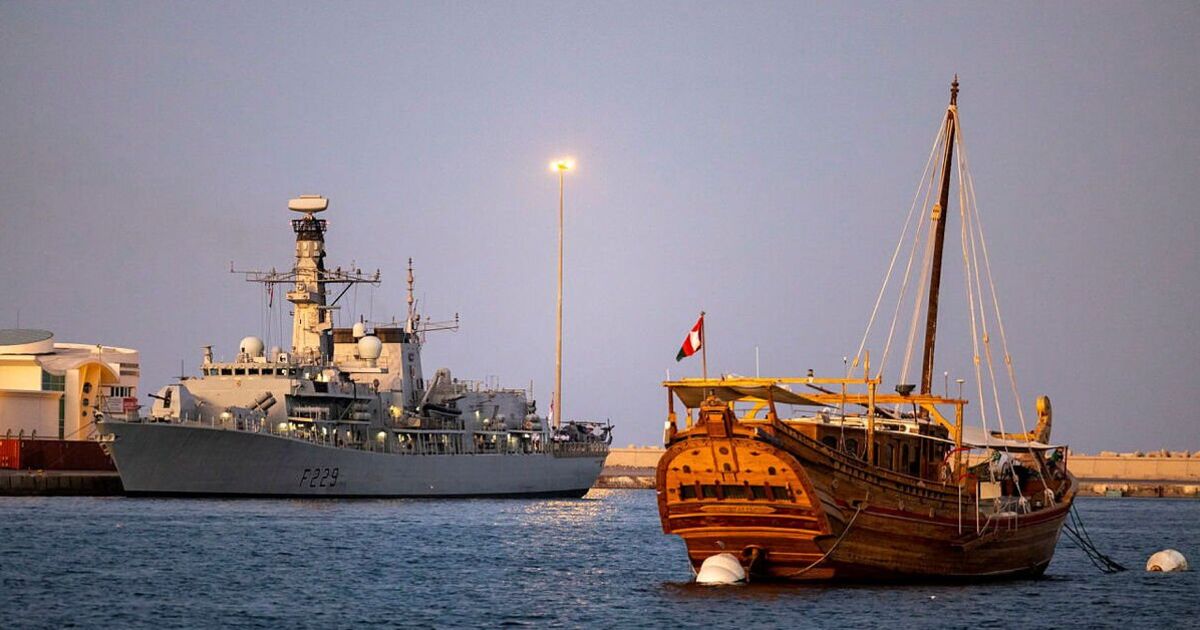Britain is to downgrade its military posture in the Middle East next month due to a shortage of operational Royal Navy frigates, sources said last night. For the last three years, HMS Lancaster and two minehunting ships have been at the centre of Operation Kipion – a long-standing air and maritime presence in the Persian Gulf and Indian Ocean, intended to promote enduring peace and stability and ensure the safe flow of oil and trade.
But a shortage of frigates means that when the vessels end their tour next month, they will be replaced with just an autonomous minehunter. HMS Lancaster has been busy since deploying to HMS Jufair in Bahrain. The £40m base was opened in 2018 as the UK’s first new overseas military base in 50 years, hailed at the time as a symbol of ‘Global Britain’. The 4,300-tonne Type 23 frigate has served as a key intelligence platform for Britain in the wake of Iran’s aggression in the Strait of Hormuz.
Its complement of Royal Marines and Wildcat helicopters helped seize more than £250 million worth of drugs in the Indian Ocean and Gulf of Oman in the past year.
In 2023, they assisted in the evacuation of Sudan and, along with the US, helped to intercept an attempt by Iran to smuggle anti-tank guided missiles and medium-range ballistic missile components to Houthi rebels in Yemen.
At the time, the then Defence Secretary Ben Wallace hailed the “permanent presence of the Royal Navy in the Gulf region to support our commitment to uphold international law and tackle activity that threatens peace and security around the world.”
Last week, the Royal Navy confirmed that three autonomous minehunters had entered service for the first time. The crewless drones are designed to locate and detonate naval mines without putting personnel in harm’s way.
While they will be crucial if Iran chooses to mine the vital Strait of Hormuz, they cannot replicate the capabilities of a warship.
“It’s like comparing a three-course meal with a biscuit,” said defence expert and former Royal Navy captain Commander Tom Sharpe.
“Minehunters, even autonomous ones, can do one thing very well. But they have no command and control, no communication systems, and no defensive suites.
“A patrolling frigate can cover the whole Gulf, getting in among fishing communities, using its helping force to magnify intelligence gathering – it’s all vital stuff.”
The move will also affect the UK’s contribution to the US-led 46-nation Combined Maritime Forces group, which focuses on counter-piracy and counter-terrorism in the region.
The UK holds a deputy command role in the group, says Commander Sharpe, largely because of its past contributions to the region.
Those past deployments have seen HMS Montrose and HMS Kent focus on disrupting terrorist organisations’ use of the sea in the Gulf of Aden, Arabian Sea, Indian Ocean and Red Sea; HMS Somerset and RFA Fort Victoria take a leading role in anti-piracy patrols in the Gulf of Aden and Somali Basin; and HMS Montrose, HMS Dragon, and HMS Defender escort UK-flagged vessels during periods of heightened tension with Iran.
“We earned that position because we’ve had presence in the region,” said Commander Sharpe. “Just a few years ago we had five ships there – four minehunters and a frigate or destroyer.
“We hung on to it because we are better friends to the US than the French.”
But senior Pentagon officials were less sympathetic when a lack of crew meant Britain was unable to deploy a carrier to the region last year.
On paper, the Royal Navy has eight frigates left in service.
But of those, three are in maintenance and a fourth is deployed in the Indo-Pacific with the carrier HMS Prince of Wales and Task Group 25.
If reports that HMS Lancaster will be scrapped upon her return are true, that leaves just three deployable frigates in the surface fleet.
This still means Britain could hastily deploy one to the Gulf if tensions rise, but the ability to post one there permanently has gone – for now.
“There’s no question it’s a downgrading of our posture,” said Falklands hero Admiral Chris Parry.
“We’re replacing a platform with a system we could simply lease – it’s not something that needs sovereign capability at all. It’s not really indicating our presence in the region.”
He added: “It’s all very well to say that we can deploy a frigate if the need arises, but if you have the right presence already in place, you don’t let things heat up to begin with.
“We’re in the business of deterrence, not reacting to what other people are doing.
“These autonomous minehunters don’t have the sort of all-round general-purpose capability of a warship. Essentially, they’re just replacing what the other minehunters were doing. In terms of presence in the Gulf, it’s negligible.
“But we simply don’t have enough warships to cover our commitments at the moment.”
A Ministry of Defence spokesperson said: “The Royal Navy continues to conduct complex operations around the globe, including leading the multinational CSG deployment which is currently in the Indo-Pacific.
“The UK has a long-standing maritime presence in the Gulf, and the UK Maritime Component Command in Bahrain continues to be central to the UK’s military operations across the Middle East region.
“This includes the deployment of a minehunting capability.”

